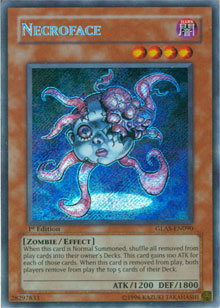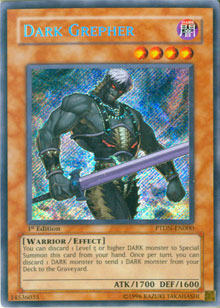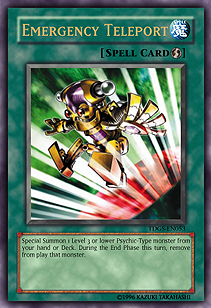 This past weekend we saw Teleport Dark Armed decks dominate at Shonen Jump Championship Tulsa. It was played by eleven of the Top 16 duelists: three of them made it to the Top 4, and the final match of the day saw two Dark Armed players go head to head. The deck was immensely popular and halfway through the day it had claimed most of the seats at the top ten tables—close to 80% of them.
This past weekend we saw Teleport Dark Armed decks dominate at Shonen Jump Championship Tulsa. It was played by eleven of the Top 16 duelists: three of them made it to the Top 4, and the final match of the day saw two Dark Armed players go head to head. The deck was immensely popular and halfway through the day it had claimed most of the seats at the top ten tables—close to 80% of them.
So newsflash: Teleport Dark Armed is really good. It’s probably unnecessary for me to recap that, as it was established yesterday when Adam Corn won his title. But at the same time, the number-one quote from the weekend that keeps running through my head was Velvet Jones’s comment in his Round 8 feature match, when he stated that the "deck still has a long way to go." Velvet’s remark was largely influenced by a comparison betweenthe Dark Armed Dragon decks right before last summer’s emergency format changes, and the progenitor versions played at Shonen Jump Championship Houston. The versions at Houston made a huge impact, but compared to the builds that emerged over the weeks that followed, those first attempts were a joke. And that might be the exact situation we’re in now—there’s still so much room for Teleport Dark Armed to grow.
The Big Problem
I think the one major weakness Teleport Dark Armed suffers was illustrated perfectly in Game 1 of the Top 16 feature match between Ryan Spicer and Cesar Gonzalez. There, we saw big aggressive plays from each duelist met with even stronger defensive tactics—the result was a strong push from Cesar that stopped 150 life points short of winning the match. It was followed by a topdecking war and eventually Spicer captured an unlikely win, dropping Cesar from 8000 life points to 0 in a matter of turns. Both decks burnt themselves out early, and Spicer managed to pull out the win simply because he had a couple of tricks left and Cesar didn’t. But regardless of the comeback one point remains: both decks totally ran out of steam halfway through the duel.
And that’s the problem—while Teleport Dark Armed’s early game is incredible enough to usually win the duel then and there, its long game isn’t very good. Jermol Jupiter won Shonen Jump Baltimore strictly because he could slow the deck down and steal its ability to take early wins. In the weeks since, many duelists competing at Regional Qualifiers have learned what Jupiter seemed to be aware of all weekend. If you can answer the early-game threats the deck throws at you it’s tough to lose. The Teleport deck just can’t do anything to you once it runs out of Synchro summons and fills its graveyard past the point of Dark Armed Dragon.
Let’s break it down: the most successful Teleport Dark Armed builds we’ve seen so far run three Tuners, one copy of Caius the Shadow Monarch, and one copy of Crush Card Virus. Alternate builds can run as many as five Tuners, two Caius, Crush Card, and even off-beat  picks like one or more copies of Destiny Hero - Plasma. That means the average Teleport deck requires as few as five fodder monsters to serve as tributes and Synchro materials—but in many cases that number will be far higher, perhaps even double . In the meantime Monster Reborn and Dark Grepher can fill some of the material and tribute needs, and you can always use Teleport to get tribute fodder, but really, the ideal monster to play with all of those costed cards is usually Destiny Hero - Malicious. He’s the perfect level to match Krebons, he pairs with Crush Card Virus, and tributing him or sending him to the graveyard doesn’t usually cost you card presence. That last point is a big one because it sets the precedent for our expectations: those Synchro materials and tributes? They should be free.
picks like one or more copies of Destiny Hero - Plasma. That means the average Teleport deck requires as few as five fodder monsters to serve as tributes and Synchro materials—but in many cases that number will be far higher, perhaps even double . In the meantime Monster Reborn and Dark Grepher can fill some of the material and tribute needs, and you can always use Teleport to get tribute fodder, but really, the ideal monster to play with all of those costed cards is usually Destiny Hero - Malicious. He’s the perfect level to match Krebons, he pairs with Crush Card Virus, and tributing him or sending him to the graveyard doesn’t usually cost you card presence. That last point is a big one because it sets the precedent for our expectations: those Synchro materials and tributes? They should be free.
So we’ve got a need for five free tributes or materials (potentially many more), and Malicious can only really provide two. There’s some fudging that can be done by reallocating other effects, but the deck is basically a six-shot magnum with only two or three bullets in the chamber. That’s poor, especially since the potential is there—if the free monsters kept flowing, the deck could definitely put them to work.
Interestingly enough, if you remember Jerome’s Synchro Dude deck from Baltimore, it effectively followed the opposite play pattern: Jerome passed on the explosive early game of Emergency Teleport and Psychic Tuners in exchange for superior removal spells and Mind Control, the latter of which gave the deck a strong mid- and late game. With three copies of Malicious and up to four stolen monsters, the Synchro Dude deck only rarely runs out of plays—it doesn’t burn out nearly as easily as the more conventional Teleport deck. But that particular solution isn’t feasible for Teleport Dark Armed because it doesn’t have the room to play multiple copies of Mind Control. Nor would it solve the deck’s tribute woes—only its Tuner trouble.
Whoever finds the solution to this problem is going to be in a good position for future events, and frankly, I think duelists like Velvet Jones, Fili Luna, and Corey Defeo have found it. None of these three duelists made it to Day 2 in Tulsa, but they did make some promising innovations regardless, and the best tech in their arsenal was Necroface.
It Gives the Deck a Mid- and Late Game
I’ve been mincing words a bit, so I just want to be clear: Teleport Dark Armed as it stands right now has no long game. It explodes early and wins or loses from there. But Necroface changes all of that, and unlike Mind Control, the return on your deck space investment is tremendous. All you need is a single copy to completely change your deck.
How do you use it? Just wait until you have two copies of Malicious removed with your third in the graveyard. Then normal summon Necroface to use its effect, and shuffle those two copies of Malicious back into your deck. From there you’re free to remove the Malicious in your graveyard to special summon another, and that one can be removed for your fourth free Malicious of the game. You’ll suddenly have double the amount of your preferred ammunition.
Right now, a lot of duelists are running Destiny Hero - Fear Monger just for the slim chance of reloading one Malicious, let alone two. And while Fear Monger’s effect can be triggered by a suicide attack made at your discretion, most players seem to be setting it and hoping their opponent blunders into the thing. It’s not a very strong strategy against experienced duelists, who will generally make the right read and avoid attacking the Fear Monger until they can either neutralize its effect or remove it entirely from the field with something like Snipe Hunter or Caius the Shadow Monarch. Just look at Adam Corn’s Destiny Hero lineup—he main-decked Destiny Hero - Doom Lord and Destiny Hero - Diamond Dude, and even sided Destiny Hero - Defender. But there was no Fear Monger in sight, and for good reason.
Necroface is a different story: it’s simple, it has double the impact of a successfully resolved Fear Monger, and most importantly it’s proactive. You don’t need to set Necroface and hope your opponent makes a bad play to get your cards back—you just have to normal summon it to instantly achieve your goal.
The best part? Unlike Mind Control, you can essentially create a mid- and late game for Teleport Dark Armed by adding just one copy of Necroface to the deck. Since you don’t need to draw it in the early game and you tear through so many cards anyway with all the drawing and searching you do, it’s pretty reliable . . . and searchable with Sangan, too.
It Solves Other Problems Too
Necroface might be worth playing if it was simply a narrow card that sent two copies of Malicious back to your deck, but it’s far more than that. It also works to counter the long-term damage of a number of cards seeing heavy play right now.
If your opponent removes something from your graveyard with D.D. Crow, Necroface can return it to your deck. Krebons is a common target for the Crow’s effect, and shuffling the Tuner back means you won’t run out of targets for Emergency Teleport. That can be a problem, because with three copies of  Teleport and three Krebons, you’ve got an even chance of drawing either one in your opening hand. Every time you draw a copy of Krebons, one Teleport will be useless unless you happen to main-deck Psychic Commander. There won’t be anything to summon with it. But if you remove that Krebons with Allure of Darkness, or if your opponent removes it with an effect, you can add it back to your deck and bring that third Teleport back online.
Teleport and three Krebons, you’ve got an even chance of drawing either one in your opening hand. Every time you draw a copy of Krebons, one Teleport will be useless unless you happen to main-deck Psychic Commander. There won’t be anything to summon with it. But if you remove that Krebons with Allure of Darkness, or if your opponent removes it with an effect, you can add it back to your deck and bring that third Teleport back online.
The same trick works in the face of Caius the Shadow Monarch and Doom Lord, two more cards that are commonly used to remove Krebons when its effect would negate attacks. If Kycoo the Ghost Destroyer removes important monsters, Necroface can get them back as well, and you can even return choice Dark monsters to your deck for a second go by using them as fodder for Dark Armed Dragon.
Just remember that Necroface shuffles your opponent’s removed cards back into his or her deck as well—you need to time things so you can use that to your advantage, or at least use it safely. For instance, if both you and your opponent have two copies of Malicious removed and one in the graveyard, but returning your two Malicious to your deck won’t win you the game this turn, you’ll probably want to hold off until you see more cards.
But the other side of the coin is important too: sending cards back to your opponent’s deck can have surprising benefits. If your opponent activated Gold Sarcophagus to remove a card you can stick it back into the deck: doing so basically turns Sarcophagus into a blank spell card. Remove a monster from play with Destiny Hero - Doom Lord’s effect, and Necroface can stuff that monster back into the deck before your opponent’s second standby phase rolls around. Your opponent won’t get the monster back to the field as a result.
There will be rare games where Necroface’s ATK boosting ability can do some serious damage, and it’s got intriguing synergy with Allure of Darkness. Remove Necroface for Allure, and both you and your opponent will lose the top five cards off your deck. That’s probably not useful in your day-to-day dueling, but if you used Phoenix Wing Wind Blast on something and you really don’t want to see it again next turn, Necroface can arrange that.
There is so much to this card right now, starting with the huge ability to rescue Malicious and working down to a ton of smaller uses. I think Velvet and the rest are really onto something here, and if you try it yourself, I think you’ll agree. This card does something totally unique, and it does it very well. Necroface has dropped to about half of what its previous secondary market value once was, so get yours now before it skyrockets again.
—Jason Grabher-Meyer